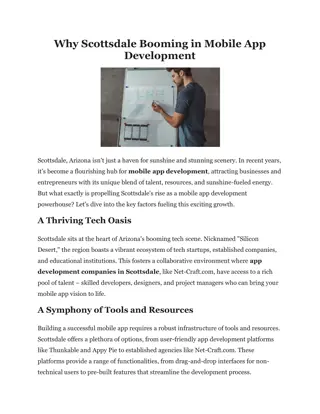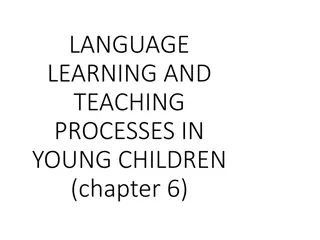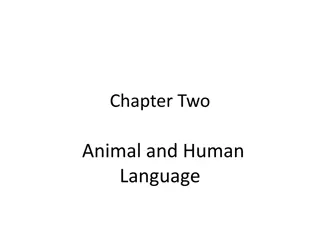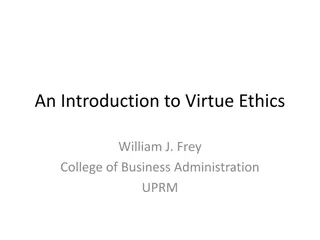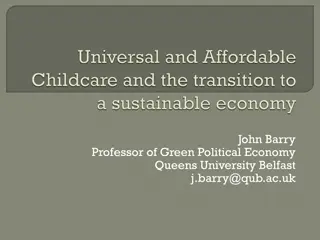Understanding the Importance of Language Development for Human Flourishing
Language is essential for human species, influencing health, productivity, and social well-being. Recognizing the significance of spoken and written communication is crucial for personal growth and societal advancement. Early childhood experiences play a vital role in language development, emphasizing the importance of nurturing language skills from infancy for optimal cognitive development.
- Language development
- Communication skills
- Early childhood education
- Human flourishing
- Cognitive development
Uploaded on Apr 16, 2024 | 6 Views
Download Presentation

Please find below an Image/Link to download the presentation.
The content on the website is provided AS IS for your information and personal use only. It may not be sold, licensed, or shared on other websites without obtaining consent from the author. Download presentation by click this link. If you encounter any issues during the download, it is possible that the publisher has removed the file from their server.
E N D
Presentation Transcript
How can we help language flourish? Sheena Reilly PhD FAAHMS, FASSA, FRCSLT(UK), FSPAA Pro Vice Chancellor Health, Griffith University
Spoken language Defines the human species Underpins the health, productivity, and social well-being of individuals (ultimately, the human capital of a nation)
Speech and Language Speech production of sound shaped by the articulators to produce recognisable sounds and form words Language - oral, written, gestural (signed) - expression and comprehension
Increased recognition: importance of spoken and written communication Critical to achieving full potential Shift from Brawn to Brain Poor language and literacy - not always viewed as disability Highly desirable skills determine employability Rueben 1998
Proportion of employed people in production and service industries: 1966-2011 Blue collar - hands on physical work White collar - service industries 1900
How can you help language flourish? By understanding: How language develops What goes wrong Why it matters
Structure & design of the brain is almost complete The infant brain develops nerve connections at an unparalleled rate Language pathways are being developed in the brain The first 5 years are critically important for the development of language Infants learn by doing things, listening to speech & being read to Age 3 Age 3 sentences Age 1 Age 1 first words Age 1 Age 1- -2 2 ~200 words + phrases Age 4 Age 4- -5 5 written letters & words Pregnancy Pregnancy Newborn Newborn Age 1 Age 1 Age 3 Age 3 Age 5 Age 5 Age 8 Age 8 Hears noise, music & voices Early communication experiences Exposure to: quality parent child interactions play; books & reading; songs; social communication; quality early childhood education Orientates to voices & music heard in utero Expresses early needs via crying, cooing & vocalising
What is this? http://www.humanconnectomeproject.org
The first 1000 days critical for language development Developmental experiences + social context shape capacity and have lifelong impacts Brain building neuronal connections and brain architecture Brain pathways - shaped by the environment and experiences https://www.rch.org.au/uploadedFiles/Main/Content/ccchdev/CCCH- The-First-Thousand-Days-An-Evidence-Paper-September-2017.pdf
How language develops What goes wrong Why it matters
Structure & design of the brain is almost complete The infant brain develops nerve connections at an unparalleled rate Language pathways are being developed in the brain A complex process - things can go wrong at anytime The first 5 years are critically important for the development of language Infants learn by doing things, listening to speech & being read to Age 3 Age 3 sentences NATURE OF LANGUAGE DEVELOPMENT Age 1 Age 1 first words Age 1 Age 1- -2 2 ~200 words + phrases Age 4 Age 4- -5 5 written letters & words Pregnancy Pregnancy Newborn Newborn Age 1 Age 1 Age 3 Age 3 Age 5 Age 5 Age 8 Age 8
1 in 5 children start school with poor* language development *less than optimal language on standardised measures
The Early Language In Victoria Study (ELVs) - A longitudinal study of 1,910 children - Recruited from 6 LGAs representative of Melbourne. Phase 1: Infancy (8-10 months) to preschool1 (4 years), Phase 2: Early school years2 (5-7 years). Phase 3: Middle to High School3 (9-13 years). NHMRC project grants: 1#237106 2#436958 3#1041947
Multiple waves of data Age 8mth 1 2 3 4 5 6 7 8 9 10 11 12 13 14 Q Q Q Q Q Q Q Q Q Q Q A A A A A T T T T T C C C C P P L L L Q : Parent-report questionnaire A : Face-to-face assessment P: Parent language and literacy assessment T: Teacher report C: child self report L: Linked data
Language: Expressive vocabulary at 2 years n =1742 679 O 234.7 287.7 words 261.3 Mean SD Range Total 261.3 162 0 - 679 Girls 287.7 159.7 0 - 679 Boys 234.7 160.6 0 - 679 * MB-CDI: Fenson et al, 1994 (Reilly et al Pediatrics 2007; Reilly et al IJSLP 2009)
Late talkers A toddler (between 18-30 months) who has good understanding of language, typically developing play skills, motor skills, thinking skills, and social skills, but has a limited spoken vocabulary for his or her age. All the building blocks for spoken language, yet they don t talk or talk very little. ww.hanen.org/helpful-info/articles/how-to-tell-if-your-child-is-a-late-talker- -and-w.aspx
Late talkers Dr Google 350 million articles on late talking - 79 million articles on late talking when to worry How to Encourage a Late-Talking Toddler to Speak Parents can rest easy, late-talking kids developing at their own rate How to tell if Your Child is a Late Talker and What to Do about It Late Talkers: When Is It a Problem? - Parents Magazine Late Blooming or Language Problem?
Late talkers* at 2 years 19.7% (n = 333) 261.3 679 O words < 79 Average words 39 < 119 Average Words 65 * MB-CDI: Fenson et al, 1994 (Reilly et al Pediatrics 2007; Reilly et al IJSLP 2009)
Late talking: can it predict later language disorder? Late talking alone is not a reliable indicator of later language difficulties Reilly et al 2010; Reilly et al 2014
Trajectory is important Children can start: Slow and stay behind Behind and catch up On track and stay on track On track and fall behind 22
Behaviour is a form of communication Don t overlook the role behaviour plays as a form of communication DLD often has no outward signs http://pamelasnow.blogspot.com
How language develops What goes wrong Why it matters
It matters because Oral and written language are the foundations for learning Children who start school with poor language: Less likely to: Be literate and numerate, finish school, gain a qualification. More likely to: Have problems with behaviour and mental health, be unemployed, be in the youth justice/prison system*. *50% of these young people have a previously undiagnosed DLD
It matters because Developmental Language Disorders: the most common condition you ve never heard of More common than Autism, Dyslexia and many other conditions Department name (Edit in View > Header and Footer) Prof Dorothy Bishop Univ of Oxford
Quality of Life Declining QoL (an individual's sense of well being*) can be detected as early as 4 years in children with Developmental Language Disorders (DLD) QoL continues to decline in children with DLD compared to their peers between 4 and 9 years Eadie et al 2018 *as reported by parents
How can you help language flourish? Understand: How language develops What can go wrong Why it matters You have a critical role in the promotion of language development, the early detection and management of language problems
Recommendations Fluidity is common in the early years children develop at different rates There is no one time between 0-3 when a single assessment confidently predicts later language disorder Check progress regularly - Don t rely on a single indicator or milestone Be alert (but not always alarmed e.g. late talking in isolation)
http://www.talkingpoint.org.uk/progress-checker Department name (Edit in View > Header and Footer)
Recommendations Positive parenting to promote quality interactions Universal language promotion enhances and does no harm Quality early childhood education Target vulnerable populations Developmental language disorders impact all social groups
Acknowledgements Centre for Research Excellence in Child Language - Gold, Goldfeld, Law, McKean, Mensah, Morgan, Tomblin, Wake, Early Language In Victoria Study - Bavin, Bretherton, Carlin, Eadie, Gold, Prior, Mensah, Okoumunne, Wake. Hearing Language and Literacy group - Cini, Conway, Pezic




